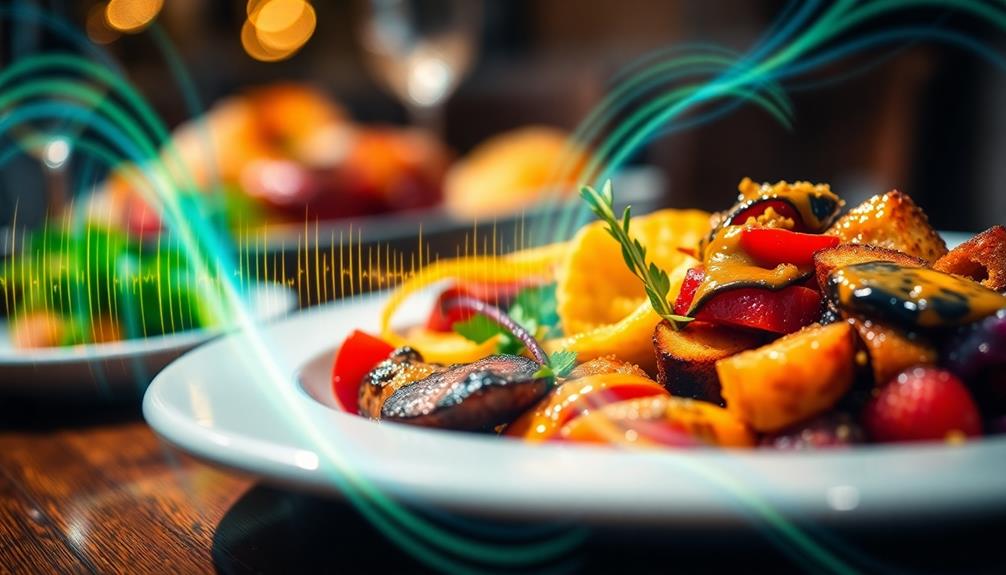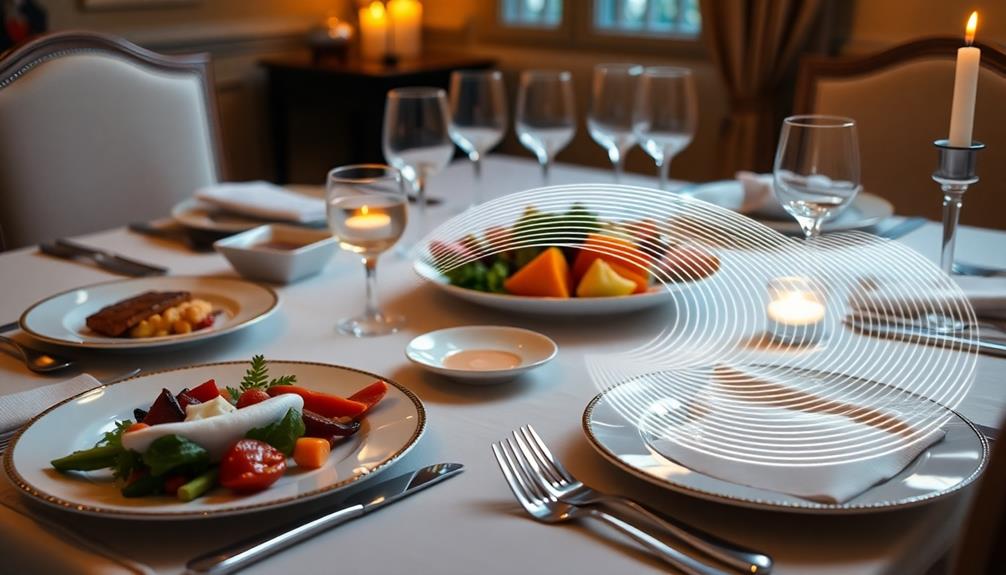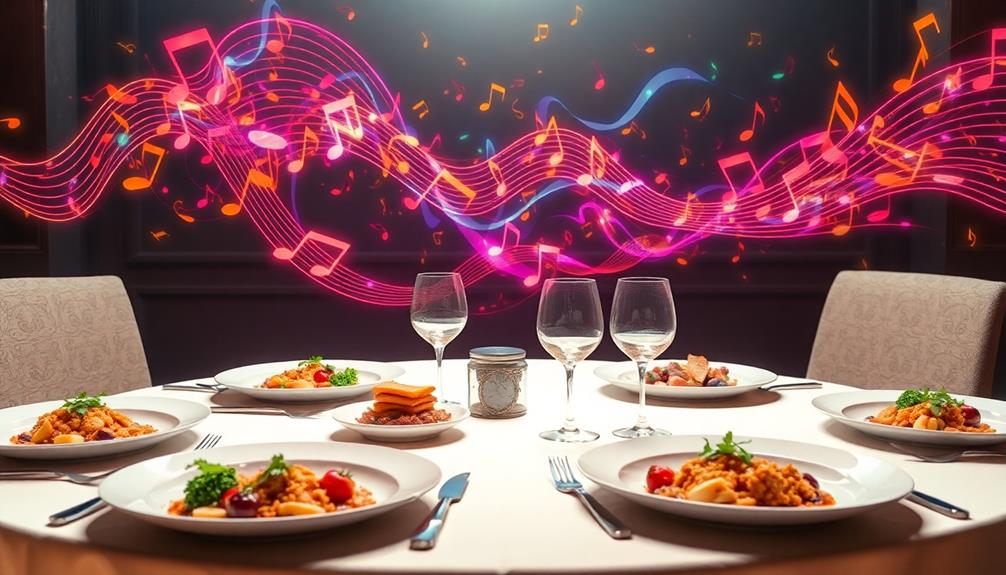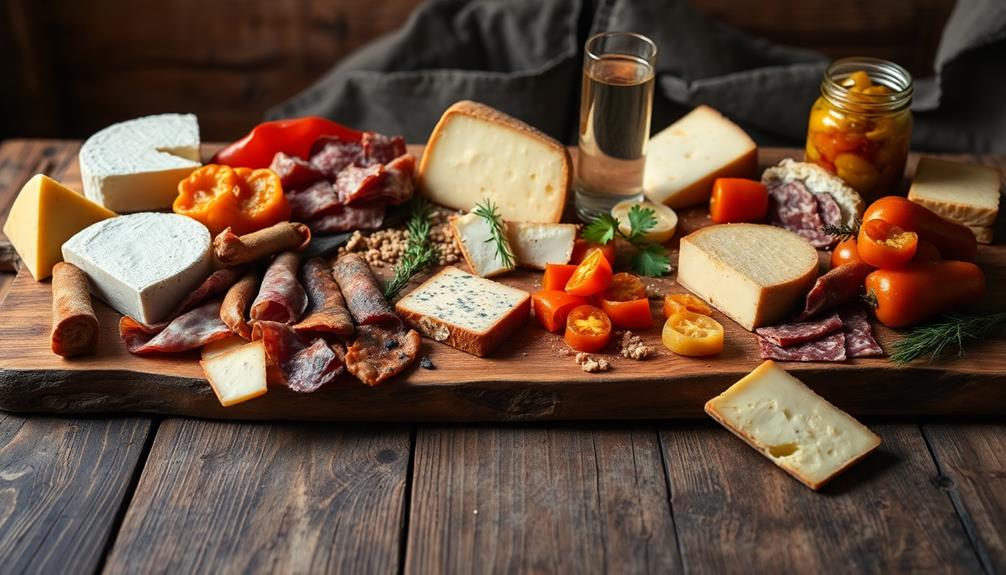Certain sounds can enhance your dining experience by making your food taste better. You may have noticed that hearing crunching or crackling sounds can enhance the perception of freshness and texture. Higher-frequency sounds can make foods like chips seem crisper and more enjoyable. The ambiance around you, including background music and noise, can also influence how you perceive flavors, ultimately enhancing your overall enjoyment of the meal. When you hear satisfying sounds while eating, your brain automatically associates them with better taste experiences. If you’re interested in learning more about how sound can transform your dining experience, there is plenty more to discover.
Key Takeaways
- Higher-frequency sounds enhance the perception of food crispness, making snacks taste fresher and crunchier.
- Auditory cues, like crunching sounds, stimulate taste receptors, amplifying flavor enjoyment during consumption.
- Background music influences flavor perception, with positive tunes enhancing food quality and overall dining experience.
- Noisy packaging and food sounds create expectations about texture and quality, improving the anticipation of taste.
- Cultural sound associations affect taste perceptions, highlighting the significance of familiar sounds in enhancing food enjoyment.
The Science of Sound and Taste

The connection between sound and taste might surprise you, but research reveals that our auditory experiences can greatly influence how we perceive flavors. For instance, studies led by Prof. Charles Spence show that higher-frequency sounds, specifically those above 2 kHz, enhance your perception of food crispness. When you munch on noisier Pringles crisps, you're likely to rate them as 15% fresher and crisper compared to quieter ones.
This phenomenon can be particularly noticeable during festive gatherings, such as when enjoying Graveyard Taco Dip at Halloween parties, where the crunch of tortilla chips adds to the overall enjoyment.
The sounds associated with eating—like crunching and crackling—serve as essential cues that your brain uses to interpret texture, which directly affects your taste perception. Additionally, background noise and music can change how intense you find flavors; positive sounds can enhance your enjoyment, while negative sounds can detract from it.
This integration of sound and taste happens automatically in your brain, where specific sounds can even evoke emotional responses that influence how you enjoy food. By manipulating soundscapes in dining settings, restaurants can improve how fresh and high-quality you perceive the food, leading to greater customer satisfaction.
Ultimately, the science of sound and taste highlights how intertwined your senses truly are.
How Sound Affects Flavor Perception

Sound greatly shapes how you perceive flavors, influencing everything from the enjoyment of a crunchy snack to the sweetness of a dessert. Research shows that auditory cues play an essential role in modulating your taste experience.
For instance, the satisfying crunch of Red-Braised Pork Belly can enhance the overall perception of flavor. Here are some key points to take into account:
- Higher-frequency sounds enhance perceived crispness.
- Noisy food packaging is designed to improve your eating experience.
- Background noise can alter your taste perceptions.
- Emotional responses triggered by sounds influence flavor enjoyment.
For example, louder crunching sounds from potato chips can make them seem 15% fresher than quieter ones.
Additionally, the sounds of food packaging greatly affect your perception of texture, creating a more enjoyable experience. Background noise can either elevate or diminish your enjoyment; pleasant sounds may boost flavor intensity, while excessive noise can make sweet and salty flavors less pronounced.
The Role of Auditory Cues

Often overlooked, auditory cues play an essential role in how you experience food. For instance, the satisfying crunch of loaded baked potatoes can enhance your perception of their freshness and quality. When you crunch into a chip, that satisfying sound can greatly enhance how fresh and high-quality you perceive it to be.
Research shows that louder crunching makes chips seem about 15% crunchier, influencing your enjoyment (Spence & Zampini, 2008). Additionally, the pitch of sounds can affect your taste perception; higher-pitched sounds are linked to sweetness, while lower-pitched ones can amplify bitterness (Kantono et al., 2016).
Background music or sounds also shape your eating experience. Positive auditory environments can elevate flavor ratings, while negative sounds can detract from enjoyment (Knoeferle et al., 2020).
Furthermore, the sound of food packaging can set your expectations; manufacturers often design packaging to create appealing sounds that enhance perceived crispness (Lerma & Buiatti, 2017).
Sound and Texture Interactions

When enjoying crispy foods, you mightn't realize how much the accompanying sounds influence your perception of texture. The crunch of a potato chip or the crackle of a fried snack plays an essential role in how fresh and crispy you perceive it to be. Higher frequency sounds, specifically those above 2 kHz, can enhance your experience, making those textures seem even more delightful.
Just like the satisfying crunch of chilaquiles, the auditory experience contributes to how we enjoy our food.
Consider these key aspects of sound and texture interactions:
- Noisier chips are rated 15% crunchier than quieter ones.
- The crinkling of packaging can alter your perception of food quality.
- Sounds like crunching provide critical information about texture.
- Auditory cues can stimulate taste receptors, enhancing overall enjoyment.
This relationship between sound and texture isn't just a coincidence; it's a carefully crafted experience. Manufacturers even design noisier packaging intentionally to enhance your anticipation and enjoyment.
Research Findings on Sound's Impact

Recent studies reveal just how profoundly sound affects our food experiences, transforming our perceptions of freshness and flavor. Research conducted by Prof. Charles Spence found that participants rated noisier Pringles crisps as 15% fresher and crisper than their quieter counterparts. This highlights how sound plays a significant role in how you perceive food tastes, similar to how the creamy texture of nettle soup can enhance your overall enjoyment of a dish.
Moreover, higher frequency sounds, particularly those above 2 kHz, enhance your perception of crispness in foods, showing a direct link between sound pitch and texture perception. Notably, the sound of food packaging can also influence how crisp you think snacks are. Manufacturers have even begun designing noisier packets to enhance your eating experience.
It doesn't stop there; background noise impacts your flavor intensity ratings. While white noise can diminish your flavor enjoyment, positive sounds can enhance it, indicating that auditory context is significant during food consumption.
Additionally, sound influences the perception of carbonation in fizzy drinks, suggesting that adjusting sound could enhance taste experiences, especially beneficial for those with declining taste and smell capabilities.
Practical Applications in Dining

In the world of dining, the right sounds can elevate your experience considerably, turning an ordinary meal into a memorable event.
For instance, when enjoying traditional Brazilian dishes like Caldeirada, the combination of rich flavors and the right soundscape can enhance the overall enjoyment of the meal.
By understanding how background sound influences your perception of food and drink, restaurants can create an environment that enhances your dining satisfaction.
Here are some practical applications:
- Tailored Soundscapes: Match the audio to your menu theme, creating an immersive atmosphere.
- Volume Adjustments: Use louder sounds for crunchy items to enhance their freshness perception while keeping softer music for sweeter dishes.
- Strategic Music Selections: Choose background music that aligns with the cuisine to subconsciously influence drink and food choices.
- Positive Auditory Environments: Design soundscapes that promote a sense of quality, leading to increased customer loyalty and sales.
Music's Influence on Food Enjoyment

When you sit down to enjoy a meal, the background music you choose can greatly shape how you perceive flavors.
For instance, the rich spices of a Mushroom Masala can be complemented by soft, melodic tunes, enhancing the earthy mushroom flavor.
Studies show that different genres and tempos not only affect your taste experience but also influence your emotional responses to the food.
Sound and Flavor Perception
Amid the clinking of cutlery and the murmur of conversation, the role of background music in dining emerges as an essential element that can elevate your culinary experience. Research shows that auditory cues influence how you perceive flavor, transforming an ordinary meal into a delightful event.
For instance, enjoying traditional dishes like Horiatiko Psomi alongside uplifting music can enhance both the taste and the overall dining atmosphere. Here are some key aspects to reflect on:
- Positive tunes enhance your perception of food quality.
- Different music genres can alter your flavor ratings.
- Higher-pitched sounds make you perceive sweetness, while lower pitches amplify bitterness.
- Curated sound environments can revolutionize your dining enjoyment.
Imagine enjoying a dish while listening to the soothing sound of the sea; it might just enhance your appreciation of fresh seafood. The integration of these sounds creates expectations that modify how you taste your food.
For instance, a lively soundtrack can make a meal feel more enjoyable, while a slow ballad might lead you to savor each bite more thoughtfully. By being mindful of the auditory cues surrounding your meal, you can greatly enhance your overall dining experience and satisfaction.
Impact of Background Music
Background music transforms your dining experience, creating an atmosphere that can greatly heighten food enjoyment. Research shows that positive background music improves food quality ratings and overall dining experiences.
Different genres can even alter how you perceive the taste profile of your meal, impacting flavor intensity and enjoyment levels. For instance, if you're enjoying French cuisine while listening to French music, you might find the flavors more delightful. Similarly, enjoying a dish like Dorayaki (Red Bean Pancake) while listening to traditional Japanese music could enhance the overall experience.
Moreover, the volume of background music plays an essential role in your perception. Studies indicate that louder music can enhance the crunchiness of your food but may diminish the flavors of salt and sugar. This means that the right balance is vital for the enhancement of enjoyment during your meal.
On the flip side, excessive background noise—like chatter in a bustling restaurant—can distract you from fully savoring your food, leading to reduced flavor intensity and overall satisfaction.
Restaurants that strategically select background music not only elevate their customers' experiences but also potentially boost sales. So, next time you dine out, pay attention to the music; it might just make your meal taste even better.
Emotional Responses to Sound
Music has the power to transform your meal into a memorable experience, greatly enhancing your enjoyment of food. The right auditory cues can evoke emotional responses that elevate your dining experience. For instance, the sounds of sizzling meats or boiling stews can remind you of traditional dishes like Muamba De Galinha, creating a deeper connection to cultural flavors.
Here's how music influences your perception of flavors:
- Positive tunes boost enjoyment and perceived food quality.
- Specific genres can alter how you taste different dishes.
- Background music creates expectations that shape flavor perceptions.
- Crunchy sounds enhance the sensation of freshness.
Studies show that pleasant sounds lead to positive emotional reactions during meals (Kantono et al., 2016). The emotional impact of music directly links auditory stimuli to your taste experiences (Wang et al., 2017).
Additionally, background sounds can set the mood, influencing how you savor each bite (Spence, 2015). When you hear loud crunch sounds, for example, it increases your perception of food freshness, linking those auditory cues to your overall satisfaction (Zampini & Spence, 2004).
Ultimately, the interplay between sound and food can evoke cherished memories, further enriching your dining experience (Knoeferle et al., 2020).
Cultural Variations in Sound Perception

When you think about how sound affects your food experience, cultural influences play a huge role.
Different regions have unique musical preferences that can shape your taste perceptions, making certain flavors stand out more than others.
Understanding these sound associations across cultures helps uncover why your dining experiences might vary so much from someone else's.
Sound Associations Across Cultures
Cultural variations in sound perception play an essential role in how we experience food, shaping our enjoyment of flavors through unique auditory associations. You might be surprised to learn that different cultures can link specific sounds to particular tastes.
For example:
- High-pitched sounds may evoke sweetness in some cultures.
- Lower-pitched sounds can enhance the perception of bitterness.
- Classical music might elevate the quality perception of wine.
- Cross-modal correspondence between sound and taste varies widely across cultures.
These sound associations greatly impact food enjoyment, influencing how you perceive flavors. While the connection between sound and taste is universal, the specific associations you make can differ dramatically based on your cultural background.
This means that what enhances your culinary experience mightn't hold true for someone from another culture. As research continues to explore these cultural sound-food pairings, you may uncover even more ways that auditory cues shape your dining experiences.
Embracing these diverse perspectives can enrich your culinary journey, allowing you to appreciate the intricate relationship between sound and taste in various gastronomic contexts.
Regional Music Preferences
Regional music preferences greatly shape how you experience food, as different genres resonate uniquely with various cuisines. When you dine, the sound of music plays a vital role, influencing your perception of flavors and even your emotional responses.
For instance, studies show that playing French music in British supermarkets boosts sales of French wines, proving that cultural sound associations can impact food choices.
Your enjoyment of dishes can markedly vary based on the familiar sounds that align with your cultural background. If you're listening to upbeat salsa while enjoying a spicy taco, the lively rhythm enhances the overall experience. Conversely, playing somber classical music mightn't elevate your enjoyment of a hearty stew.
As ongoing research investigates deeper into the cultural aspects of sound perception in food contexts, it becomes clear that tailoring auditory cues can enhance culinary experiences across diverse populations.
The right music can elevate your meal, transforming it from just food into a memorable event. So, next time you sit down to eat, consider how the sounds around you might enhance—or detract from—your dining experience.
Future Research Directions in Sensory Studies

The future of sensory studies holds exciting potential for exploring how sound impacts taste perception and enjoyment. As you dive deeper into this fascinating field, consider the following research directions that could redefine how food makes you experience flavors: Researchers could investigate the hidden connection between plate and taste, delving into how auditory elements—such as background music or the sound of utensils—alter our perception of flavor intensity. Furthermore, the integration of soundscapes tailored to different cuisines might unlock new ways to enhance dining pleasure. By bridging sensory and culinary arts, we can reshape how environments influence our gastronomic experiences.
- Investigate the varying effects of different sound types beyond white noise on taste perception.
- Quantify the impact of sound frequencies on specific taste profiles to enhance understanding of sound-taste interactions.
- Explore individual differences in sound perception and how they influence food enjoyment, aiming for personalized dining experiences.
- Foster collaborations between sensory scientists and culinary experts to develop innovative sound-based marketing strategies.
Future research could reveal intricate connections between sound and taste, shedding light on how auditory stimuli can enhance your enjoyment of food.
Longitudinal studies will be essential in evaluating the lasting effects of sound on your food preferences and consumption habits. By examining these elements, you can gain insights into how specific sounds can elevate your culinary experiences, ultimately transforming how you enjoy meals.
Embracing these directions won't only enhance your understanding but also pave the way for groundbreaking innovations in the food industry.
Frequently Asked Questions
Can Sounds Make Food Taste Better?
Absolutely, sounds can enhance your food experience. When you hear appealing crunches or pleasant background noise, it can elevate your perception of freshness and quality, making each bite more enjoyable and satisfying for you.
How Does Sound Affect the Taste of Food?
Sound affects your taste by altering perception. Higher pitches can make foods taste sweeter, while lower tones emphasize bitterness. Crunchy sounds enhance texture, making snacks feel fresher and more enjoyable during your eating experience.
Does Food Taste Better When It's Quiet?
Studies show that increased background noise can reduce your perception of sweetness by up to 25%. When it's quieter, you're likely to enjoy your meal more, experiencing flavors without distractions that mask their true taste.
What Is It Called When Sound Affects Our Sense of Taste?
When sound affects your sense of taste, it's called "cross-modal correspondence." This phenomenon shows how different sensory experiences interact, influencing how you perceive flavors and enhancing your overall enjoyment of food.
Conclusion
In the grand symphony of dining, sound acts as the conductor, guiding your taste buds through a harmonious experience. When you savor a dish, remember that each crunch and pop dances with the flavors, elevating your meal to a masterpiece. As you explore new culinary landscapes, let the melody of sound enhance your journey, transforming ordinary bites into unforgettable moments. Embrace this sensory interplay, and you'll discover that food, much like music, is a vibrant tapestry woven with taste and sound.










